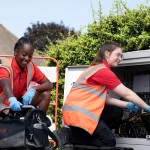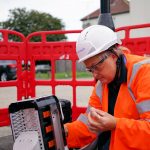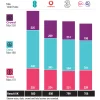Virgin Media UK Trial 8.46Gbps Home Broadband in Cambridgeshire UPDATE
Cable ISP Virgin Media has this morning announced the trial of a new 8Gbps+ (8000Mbps+) home broadband service via their Fibre-to-the-Premises (FTTP) based network, which is a small scale test that will run for six months and take place with 50 homes in the large Cambridgeshire village of Papworth.
At present the provider says they have “no plans to roll this out” and the trial is largely just an opportunity to test and learn what their “full fibre” network is actually capable of. In other words it should be viewed in a similar way as last year’s 10Gbps FTTP trial by Hyperoptic (here) or Gigaclear’s 5Gbps trial (here) from three years ago (i.e. a useful test with some marketing benefit, but not yet a real product for homes).
Otherwise the trial itself appears to be using point-to-point Ethernet Passive Optical Network (EPON) technology. This has already been used to deliver full fibre speeds of up to 1Gbps in the UK (Virgin was doing this in Papworth until last year), but the operator says they’ve been working with long-time technology partner, ARRIS, to boost this by testing new hardware (e.g. new router) and software in their residential fibre network.
Advertisement
At this point we assume they’re still harnessing Radio Frequency over Glass (RFoG) for the trial, which adapts to their cable DOCSIS signals (the communication standard for cable operators) in the home environment. This makes it easier for them to run a mixed hybrid fibre coax (HFC DOCSIS) and pure fibre FTTP network in different parts of the UK.
Meanwhile the peak download speed of 8.465Gbps (Gigabits per second) and upload of 8.14Gbps was tested and independently verified by Ofcom’s technical partner, SamKnows, who fast tracked the development of a new speed testing tool specifically designed to test multi-Gigabit connections. Other speed testing companies will face a similar challenge with the next generation of technologies.
Richard Sinclair, VM’s Executive Director of Connectivity, said:
“As the UK’s fastest widely available broadband provider, we’re committed to making Britain faster and this trial pushes the boundaries of what’s possible.
Whether it’s streaming UHD movies on Netflix, playing the latest games online or video conferencing, faster internet connections have changed our lives immeasurably over the past decade. As speed leaders, Virgin Media is not going to stand still; this trial is about looking ahead to the next decade and beyond.
With the volume of our customers’ internet usage almost doubling every year, trials like this will ensure we have the capability to meet the demand of data-hungry services in the future – be that over cable or full fibre.”
Sam Crawford, Founder and Chief Technology Officer at SamKnows, said:
“We measure broadband speeds around the world and this trial has been delivering speeds far in excess of what we typically see in customers’ homes. By using SamKnows certified measurements, Virgin Media was able to inexpensively troubleshoot issues quickly to consistently deliver innovative multi-gigabit speeds to real customers.”
Papworth, which is home to a population of around 3,000 people, has of course been used to test Virgin’s FTTP services before (since 2014) and this includes their narrow-trenching approach to civil engineering with the John Henry Group (here and here). Sadly trials of the 1Gbps service came to an abrupt end last year (here) and it now seems as if this may have been necessary for them to deploy the latest test kit.
All of this is important because Virgin’s £3bn Project Lightning network expansion expects to reach around half of its additional premises (3-4 million) via FTTP technology by the end of 2019 or 2020, although it obviously won’t have much benefit for the majority of their network on HFC DOCSIS technology. However the forthcoming DOCSIS 3.1 upgrade will be able to deliver Gigabit downstream speeds when required.
Advertisement
As usual it’s worth remarking that having a speed of 8Gbps in your home would have little benefit today since it goes well beyond the capabilities of most internet services (i.e. they can’t deliver content / data to you that fast). Furthermore it would be hampered by the limitations of other local hardware and WiFi speeds. At present it’s hard enough to make full use of 1Gbps, let alone anything faster.
Later this year, Virgin Media said they will also be making “some larger-scale network announcements” to further solidify their “speed leadership in the market.”
UPDATE 7:56am
We understand that VM are using the ARRIS E6000 CCAP CMTS edge router hardware on their side of the network (not to be confused with their customer CPE router / kit), which is also ready for future DOCSIS 3.1 upgrades. The ARRIS ONU also appears to be used as part of the customer premises (CPE) side setup.
Advertisement
UPDATE 10:07am
We’re still trying to find out exactly what broadband router (CPE) is being used for this inside the home environment, although it appears to be a device from Ruckus Networks (owned by ARRIS) and better yet it’s one equipped with the bleeding edge 802.11ax WiFi standard (aka – WiFi 6).
UPDATE 11:14am
The broadband router being used is a Ruckus R730, which is a dual-band, dual-concurrent 802.11ax AP that supports 12 spatial streams (8×8:8 in 5GHz, 4×4:4 in 2.4GHz), 1 x 5Gbps Ethernet port, 1 x 1Gbps Ethernet port and 1 x USB v2.0 port.
Mark is a professional technology writer, IT consultant and computer engineer from Dorset (England), he also founded ISPreview in 1999 and enjoys analysing the latest telecoms and broadband developments. Find me on X (Twitter), Mastodon, Facebook, BlueSky, Threads.net and Linkedin.
« Hint of Progress as Devon and Somerset Try to Fix Broadband Contract


















































Comments are closed